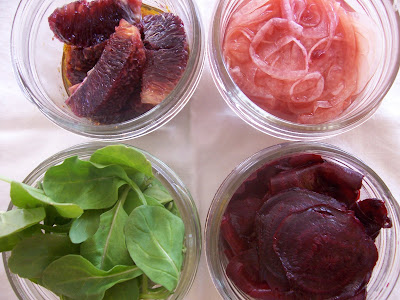
I was to bring salad along to two different events over the weekend, and mostly because I'm lazy, I didn't make the time to shop especially for those events. So, I decided that some beets, arugula and blood oranges would have to do because that's what I had in the house. And I was not disappointed after roasting the beets, pickling some onions and zesting that blood orange.
The salad was delicious with the sweet beets and blood oranges balanced with the peppery arugula and the slight tang of red wine vinegar from the pickled onions. Not bad for lazy winter day, eh?

Another perk of this salad was how well it traveled. I took it about three blocks down the street in the basket of the jogger stroller for one event and then about 50 miles away to another tucked in a bag in the back of the car. All of the toppings rode snugly in half-pint jars sealed with a lid, the onions still swimming in vinegar and the oranges in olive oil. Just before chow time, toss them all in a large bowl with arugula and enjoy. Winter may not be such a bad season after all.

Roasted Beet, Blood Orange and Arugula Salad
2 medium-sized beets, peeled and trimmed
1 large blood orange, zested then segmented
1/2 small onion, thinly sliced
4 to 5 handfuls of arugula
red wine vinegar
olive oil
salt and pepper
cheese (optional) such as Beechers or other farmhouse cheddar broken into small clumps
Preheat oven to 375 degrees. Place the beets in a baking dish, wide end down, then drizzle with oil and sprinkle with salt. Roast beets until tender throughout, about 30 to 40 minutes. Remove from oven and completely cool.
Place thinly sliced onions in a small bowl or half-pint jar. Add just enough red wine vinegar to cover onions. Set aside for at least one hour, preferably a couple of hours. Onions will be limp and pink when ready.
Zest the blood orange and put zest in another small bowl or half-pint jar. Add about two tablespoons olive oil to zest. Add a healthy pinch of salt and a little pepper. Segment the orange and transfer the segments directly into the jar with the oil mixture. Cover and set aside. Refrigerate if it is more than two hours before serving.
Thinly slice cooled beets either on a mandolin slicer or carefully with a chef's knife. Set aside beets, covered and refrigerated until ready to eat.
To prepare salad, let any refrigerated ingredients come up to room temperature. Then place arugula in a large bow. Dump in the orange and oil mixture. Add beets, separating as you go, as the thin slices will stick together. Pull the onions out of the vinegar with a fork and add to the greens. The vinegar on the onions will be enough for the dressing. Add cheese if you want then toss the whole thing together. And at the end of the meal, I suggest using a chunk of bread to mop up the beet-orange-vinegar liquid that will coat the bottom of the bowl.






